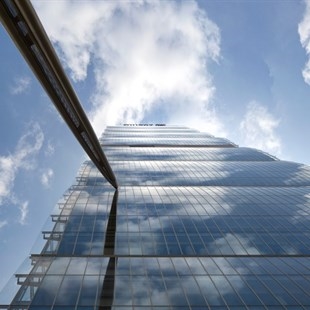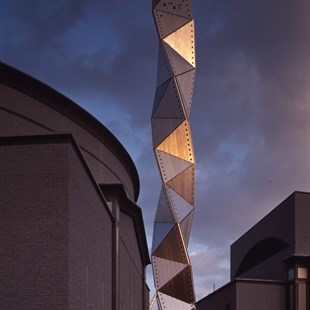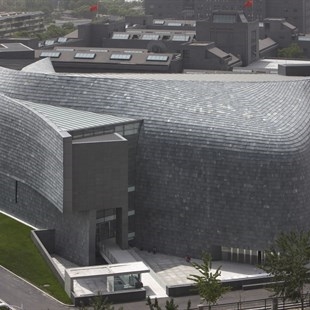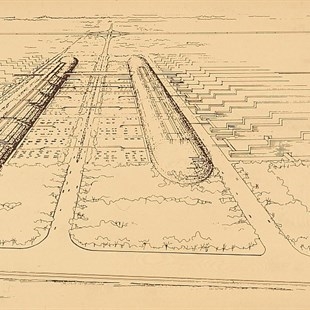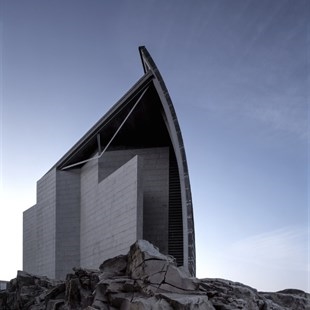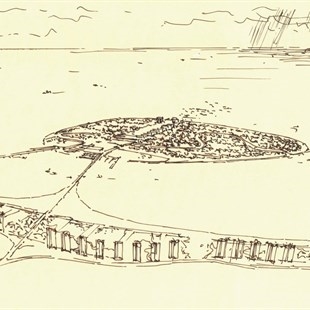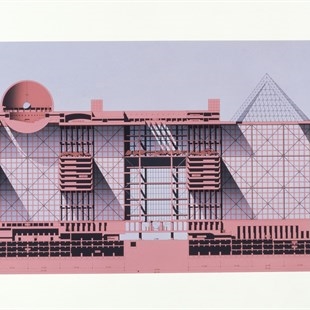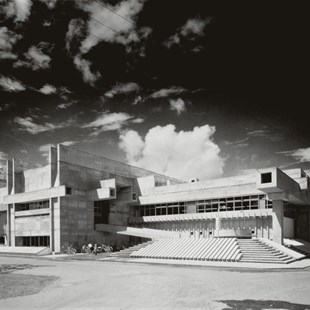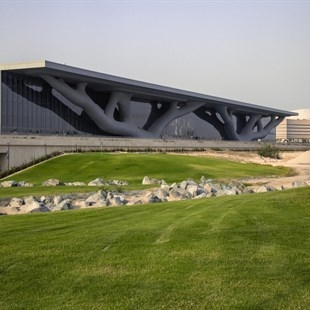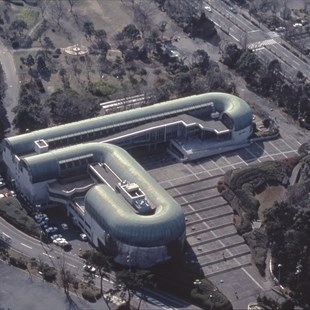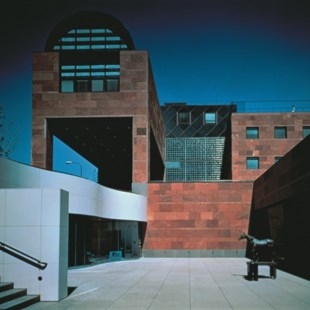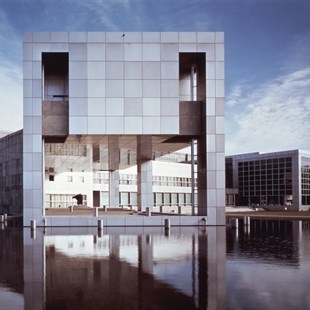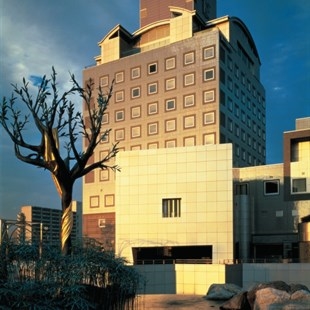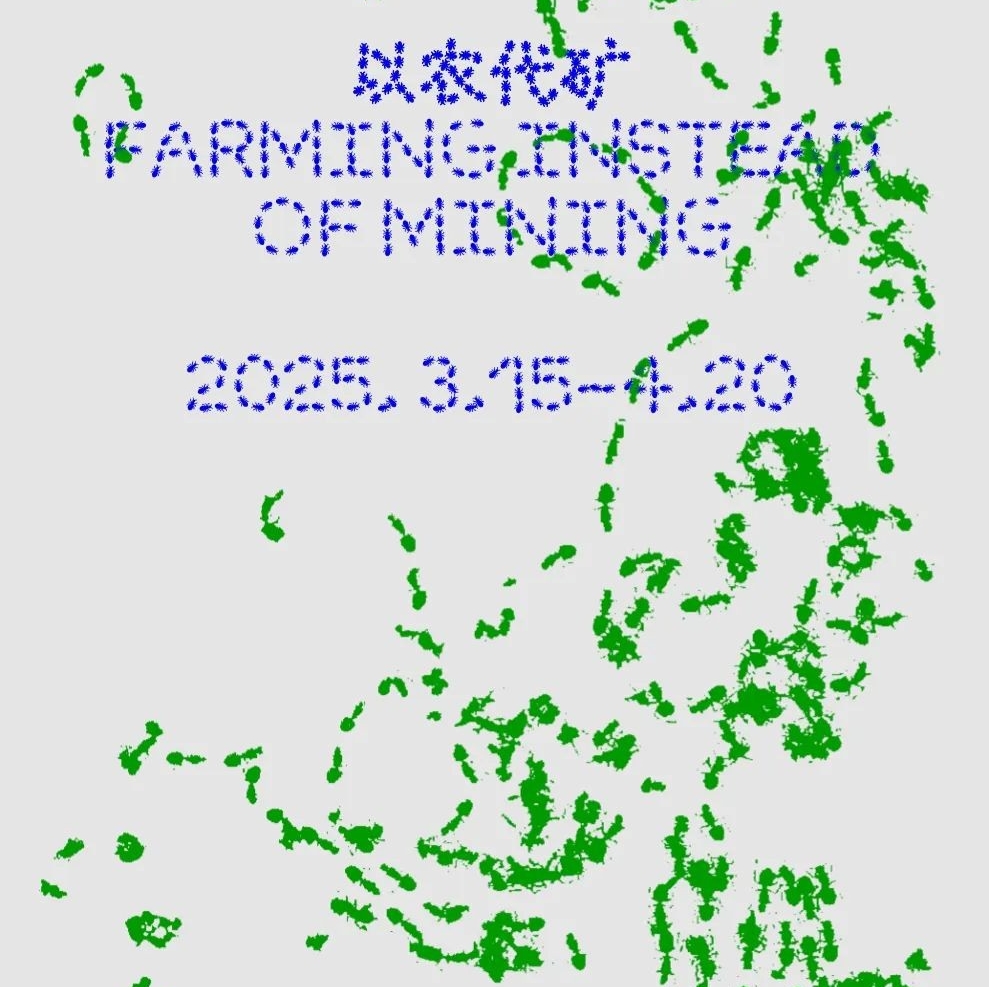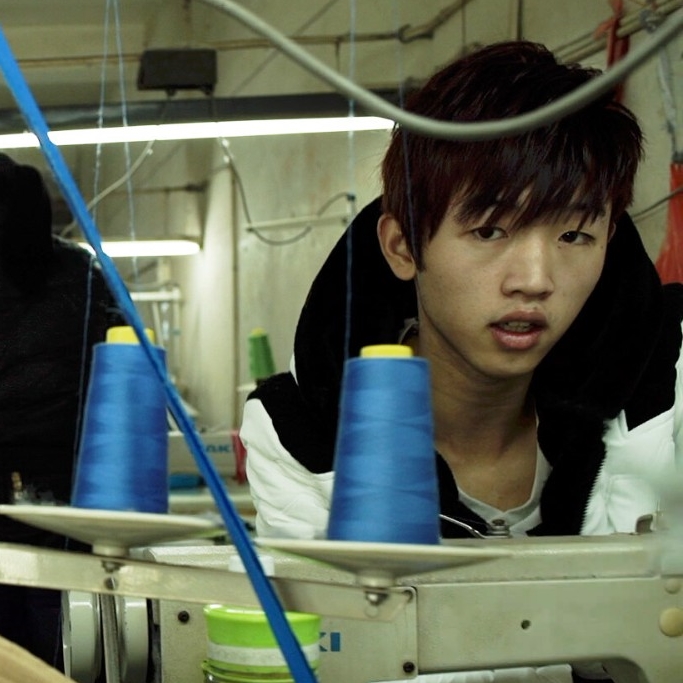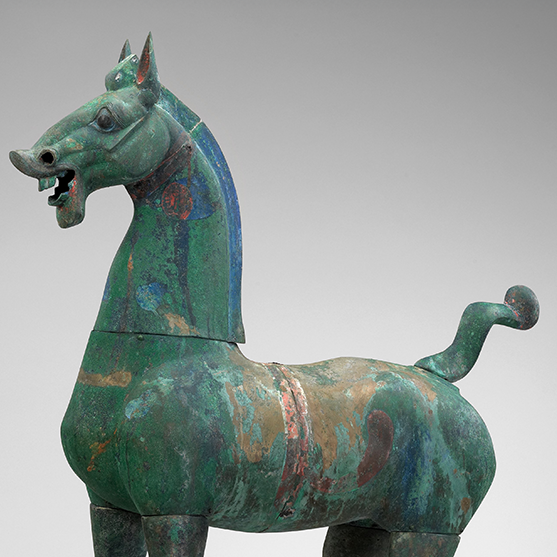 Central Academy of Fine Arts, Museum of Contemporary Art, 2003 - 2008. © Fu Xing Photo.
Central Academy of Fine Arts, Museum of Contemporary Art, 2003 - 2008. © Fu Xing Photo.
Being a comprehensive major retrospective of Arata Isozaki's architectural and artistic career, Arata Isozaki: In Formation traces the trajectory of his thoughts in different periods from multiple perspectives. The exhibition is co-curated by Li Xiangning, Dean of the College of Architecture and Urban Planning, Tongji University, and Aric Chen, General and Artistic Director of the Nieuwe Instituut.
Being one of the most creative and pioneering architects of the twentieth century, Arata Isozaki has grounded his practice in Japanese culture, but with an international perspective. He has infused historical reflections into highly creative architectural expressions. His cross-disciplinary practice between architecture and art has shaped his unique cultural perspective and extended his architectural practice from isolated spacial forms to multi-media works in social contexts. The exhibition at PSA covers a rich combination of media such as models, sketches, installations, paintings, and videos, showcasing Arata Isozaki's architectural pedigree across different phases of his career as well as his cultural and ideological practice beyond architecture in a micro-narrative way.
The exhibition organizes Arata Isozaki's practices through nine pivotal concepts, illustrating some of the lineages of Isozaki’s thinking across cultures, disciplines, and eras.

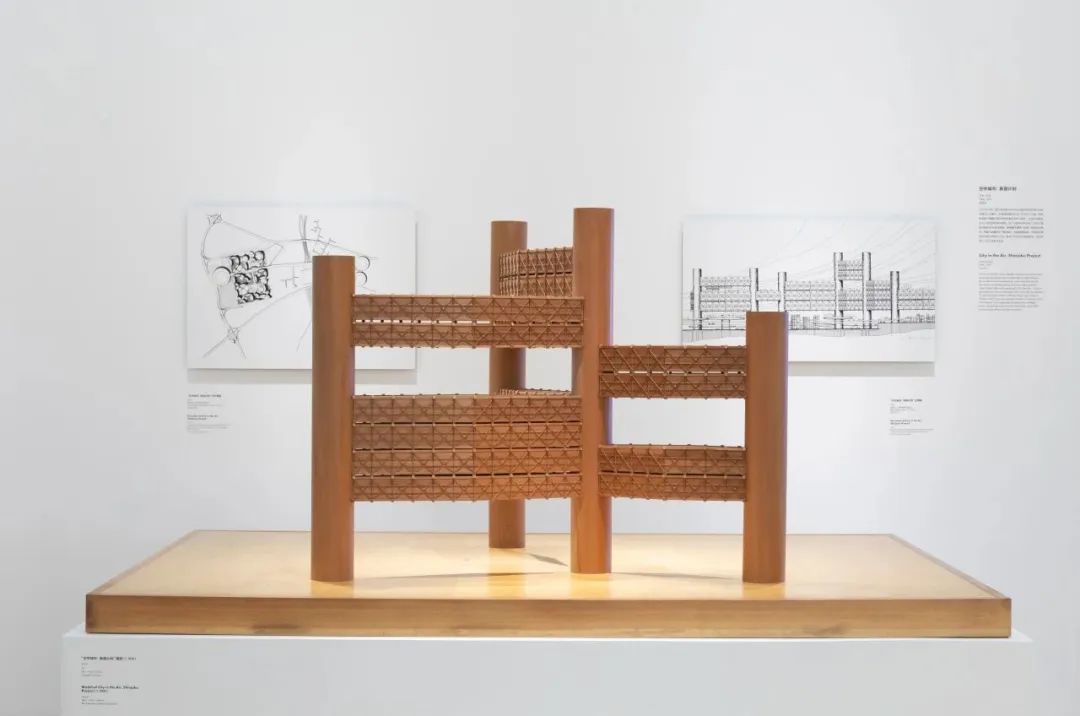



Installation view of “Arata Isozaki: In Formation”, ©️ Power Station of Art
Key Concept 1: Ruin
The image of ruins, originating in the figure of a city transformed into rubble by air raids during World War II, as experienced by the teenage Arata Isozaki, marks the point of departure for his career. Through forms including architectural conceptions, texts and installations, Isozaki developed projects including City in the Air, City Demolition Industry, Inc., and Incubation Process to criticize the linear conception of time envisaged by modern architecture and city plans.
Key Concept 2: Process
Given the reality of the irregular growth of cities in postwar Japan in the 1960s, and aware that modern planning concepts had been invalidated, Arata Isozaki proposed a new planning method that he called “process planning”, which takes account of unpredictable changes occurring after the completion of a building by incorporating such change at the planning stage. Projects highlighted in this section, including the Oita Prefectural Library (Art Plaza) and the Oita Medical Hall, are representative works that Isozaki developed with the planning method.
Key Concept 3: Cybernetics
In the 1960s, Arata Isozaki successively published several articles, proposing the concept of the “cybernetic environment”. The concept, in which urban and architectural space are interpreted as an environment controlled by cybernetics, was developed further for his subsequent projects such as the EXPO '70 Osaka, Festival Plaza, the Computer Aided City Project, and the Palladium Club.
Key Concept 4: MA/Trans
In addition to architecture and urban design, exhibition-making, both as a participant and as a curator, was another key axis in Arata Isozaki’s career. This section revisits MA: Space-Time in Japan, a ground-breaking traveling exhibition that he curated, and his work exhibited at MAN transFORMS at the Cooper-Hewitt museum in New York. Mediating the crossing of boundaries, the exhibitions exemplify Isozaki’s profound thoughts on time and space, on the West and East, and on the traditional and contemporary.
Key Concept 5: Isle
From 1964 to 1982, Arata Isozaki designed a series of independent residences, such as Nine Houses and Arai House (Responsive House) Project. Taking partial inspiration from the villas of Renaissance Italy, these projects formed conceptual islands to be scattered across contemporary cities of irregular form.
Key Concept 6: Genesis
As the underlying premises of modern architecture and urban planning were collapsing, Isozaki developed a new design theory in the 1970s to replace them, using “method” (or maniera/manner) as his keyword, which led to autonomous forms such as the cube. This was a restart from zero, a means of creation, and there was a certain arbitrariness or partiality involved in the selection. The “method” is strongly manifested in examples highlighted in this section, including the Monroe Curve / Marilyn on the Line, the Museum of Modern Art, Gunma, and the Kitakyushu Central Library.
Key Concept 7: New Form
After exploring the reductive model of pure forms based on his theory of “method,” and entering a postmodernist period of design that drew heavily from historical styles, Arata Isozaki’s study of new architectural forms progressed further, particularly in different cultural contexts in an era of increasing globalization. Among the typical works of such exploration are the Barcelona 1992 Olympic Games Main Sports Hall - Palau Sant Jordi, the Nara Centennial Hall, the Shanghai Symphony Hall, and the Shenzhen Cultural Center.
Key Concept 8: Flux
Globalization and digitalization have made contemporary society increasingly fluid. While process and transformation had always been central to Isozaki’s ideas, starting in the 1990s, they took on ever more experimental forms in projects such as the New Florence Station Competition, the Qatar National Convention Center, the Shanghai Zendai Himalayas Center, and LUCERNE FESTIVAL ARK NOVA (in collaboration with Anish Kapoor). In this period, the main stage for Isozaki’s work also further shifted to projects outside Japan.
Key Concept 9: Atlas/Archipelago
With the concept of “archipelago”, Arata Isozaki attempted to depict a world consisting of archipelagos whereby he examined the relationships between disparate parts. The Akiyoshidai International Arts Village, Mirage City, and Zhengdong New District Long Hu Area, SubCBD, Master Plan, alongside Isozaki’s travel sketches and watercolors, reflect how he approached the “archipelago” concept from different perspectives.





Installation view of “Arata Isozaki: In Formation”, ©️ Power Station of Art
Arata Isozaki: In Formation is the latest iteration of PSA’s series of “Architecture & City” Exhibitions and Researches. Since the 1980s, Isozaki’s work and ideas have had a profound influence on China’s architecture, design, art, and cultural production. His practice and thinking continue to transcend geographical and temporal boundaries, exploring the essential meanings of architecture and its interconnections with the world at large. Therefore, the exhibition aims to inspire younger generations to see new possibilities, as Isozaki would, for a present and future that will forever be “in formation”.
About Arata Isozaki
Born in Oita, Japan in 1931 (died 2022). Graduated from Architectural Faculty of University of Tokyo in 1954. Established Arata Isozaki & Associates in 1963. As a leading international figure in architecture, Isozaki designed numerous works such as the Museum of Modern Art, Gunma; the Museum of Contemporary Art in Los Angeles; and Palau Sant Jordi, 1992 Barcelona Summer Olympic Games Stadium. Recent works include Qatar National Convention Center; Allianz Tower in Milan; Central Academy of Fine Arts, Museum of Contemporary Art, Beijing; Shanghai Symphony Hall; Hunan Provincial Museum; University of Central Asia; and Zhengdong New District Long Hu Area, SubCBD, Master Plan in Henan Province, China. He juried many international architectural design competitions and also acted as a chairman at symposiums such as the ANY conferences held from 1991-2000, while curating architecture and art exhibitions worldwide. His notable curatorial works include MA: Space – Time in Japan in 1978-81. He served as commissioner of the Japanese Pavilion, La Biennale di Venezia International Architecture Exhibition (6th, 7th, 8th) and was awarded the Leone d'Oro at the Japanese Pavilion, Sensing the Future, The Architect as Seismograph in 1996. He wrote a large number of books including Japan-ness in Architecture (Shinchosha and MIT Press) and Arata Isozaki Writing as Architecture Vol.1-8(Iwanami Shoten) which compiled his writings in the last half-century. Kukane (Towards Space) (Jiuzhou Press, 2023) and UNBUILT (China Architecture & Building Press, 2004) were translated into Chinese. Going beyond the framework of architecture, he worked in a wide range of fields, including philosophy, visual art, design, studies of culture, and criticism. He was the 2019 laureate of the Pritzker Prize for Architecture.
About the Curator
Dr. Li Xiangning is Dean, Professor and Doctoral Supervisor at Tongji University College of Architecture and Urban Planning. He is a renowned architectural theorist, critic and curator, a Visiting Professor at Harvard, and Changjiang Distinguished Professor. He is the Vice President and secretary General of Committee of Architectural Criticism of Architectural Society of China, a member of the International Committee of Architectural Critics, as well as the editor in chief of the journal Architecture China. He lectured in universities and institutes including Darmstadt University of Technology, Tokyo Institute of Technology, and UCLA. Li Xiangning serves as editorial board member of many academic journals such as The PLAN and Le Visiteur (Journal of Société Française des Architectes). He has been a jury member to many international awards and competitions including Mies van der Rohe Award the European Union Prize for Contemporary Architecture, The PLAN Award, and Spanish International Architectural Award.
As a renowned architectural curator, Li Xiangning curated major exhibitions including the Chinese Pavilion at the Venice Biennale in 2018, an exhibition on contemporary Chinese architects in Milan Triennale, Harvard University GSD exhibition, Shenzhen/Hong Kong Bi-city Biennale, Shanghai West Bund Biennale, Shanghai Urban Space Art Season, and served as director for the Busan Architectural Culture Festival in 2017.
His recent books include Towards a Critical Pragmatism: Contemporary Architecture in China, Local Architecture Strategies in the Context of Globalization, and Made in Shanghai, etc.
Aric Chen is General and Artistic Director of the Nieuwe Instituut, the Netherlands’ national museum and institute for architecture, design and digital culture, in Rotterdam. American-born, Chen previously served as Professor and founding Director of the Curatorial Lab at the College of Design & Innovation at Tongji University in Shanghai; Curatorial Director of the Design Miami fairs in Miami Beach and Basel; Creative Director of Beijing Design Week; and Lead Curator for Design and Architecture at M+, Hong Kong, where he oversaw the formation of that new museum’s design and architecture collection and program.
About the Exhibition
 Dates: 26/08/2023 — 19/11/2023
Dates: 26/08/2023 — 19/11/2023
Venue: 7F, Power Station of Art
Curators: Li Xiangning, Aric Chen
Exhibition Design: Naohiko Hino
Organizers: Power Station of Art, College of Architecture and Urban Planning, Tongji University
Co-organizer: ISOZAKI+HuQian Partners
Supports: Arata Isozaki & Associates, MISA SHIN GALLERY
Principal Sponsor: LALU-JINHUA CITY
Sponsors: Tongji Architectural Design (Group) Co., Ltd., CIMA PCONSULTANCY CO., LTD.
Acknowledgement: CREATIVE APARTMENT, Nomura Foundation, Yoshino Gypsum Art Foundation
Courtesy of Power Station of Art.


